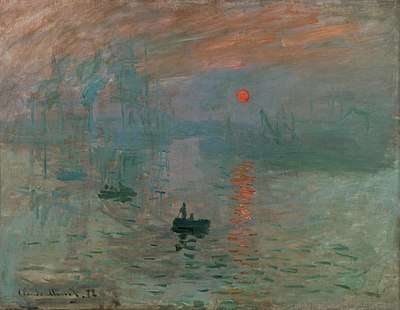Maurice Cullen (artist)
Maurice Cullen RCA (6 June 1866–28 March 1934) was a Canadian Impressionist landscape artist known for his winter scenes.
Maurice Cullen | |
|---|---|
| Born | Maurice Galbraith Cullen 6 June 1866 |
| Died | 28 March 1934 (aged 67) Chambly, Quebec, Canada |
| Nationality | Canadian |
| Education | Montreal, Conseil des Arts et Manufactures (sculpture); Montreal, with sculptor Louis-Philippe Hébert, 1880s; Paris, École des Beaux Arts, with Élie Delaunay, 1889–1892, turned from sculpture to painting; Paris, with Alfred Philippe Roll |
| Known for | Painter, teacher at Art Association of Montreal (1911) |
| Movement | Impressionism |
| Awards | Associate, Société Nationale des Beaux-Arts, Paris, 1895; Associate, Royal Canadian Academy, 1899; member, R.C.A., 1907 |
Life and work
Cullen was born on June 6, 1866, in St. John's, Newfoundland.[1] In 1870 his family moved to Montreal, Quebec. He travelled to Paris at the age of 22 to study painting at the École des Beaux-Arts and at the Académie Julian.[2] While in Paris, he was influenced by the Impressionists. In 1910 he married Barbara Merchant Pilot, a widow whose son, his stepson, grew up to be the artist Robert Wakeham Pilot. In the same year, he was invited to be a member of the progressive Canadian Art Club.[3]
Beginning in January 1918, Cullen served with Canadian forces in the First World War. He came to the attention of Lord Beaverbrook, who arranged for him to be commissioned as one of the Canadian official war artists along with Frederick Varley, J.W. Beatty and C. W. Simpson.[4]
Exhibitions
The Galerie L'Art français exhibited Cullen's works.[5] Another exhibition, Legacies of Impressionism in Canada: Three Exhibitions, was held from January 31 to April 19, 2009 at the Vancouver Art Gallery. In 2019, the National Gallery of Canada show, Canada and Impressionism: New Horizons, opened in Munich.
Selected works
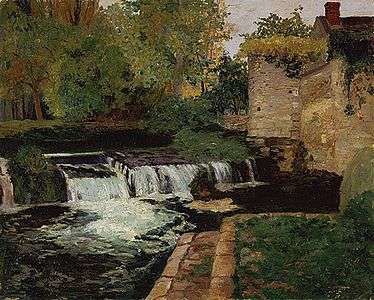 The Mill Stream (ca 1905), National Gallery of Canada.
The Mill Stream (ca 1905), National Gallery of Canada. Customs Port, Venice (1897), National Gallery of Canada
Customs Port, Venice (1897), National Gallery of Canada- Rising Tide, Le Pouldu, Bretagne (1901), Musée des beaux-arts du Québec
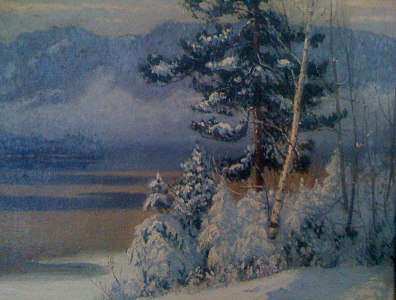 Snowfall, Lac Tremblant (1922) Private Collection
Snowfall, Lac Tremblant (1922) Private Collection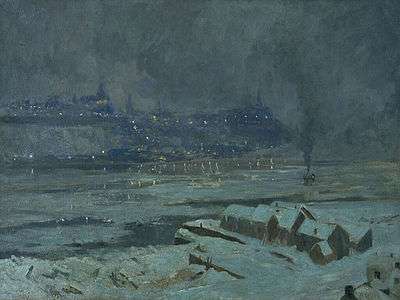 Ice Breaking, L'Assomption, (ca 1914), National Gallery of Canada
Ice Breaking, L'Assomption, (ca 1914), National Gallery of Canada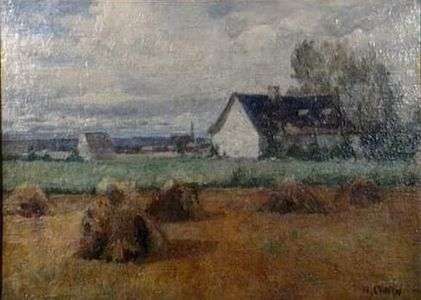 Ile d'Orleans landscape, Musée de la civilisation, Quebec
Ile d'Orleans landscape, Musée de la civilisation, Quebec No Man's Land (Douai plain, France) (1920), Canadian War Museum
No Man's Land (Douai plain, France) (1920), Canadian War Museum
Honours
- Royal Canadian Academy of Arts[6]
- He was declared a Canadian Person of National Historic Significance in 1944.[7]
See also
Notes
- Cybermuse, Maurice Cullen, bio notes Archived 2007-08-16 at Archive.today
- "klinkhoff.ca". Archived from the original on 2017-04-24. Retrieved 2016-10-03.
- "Robert Pilot". Heffel.com. Archived from the original on 2 September 2015. Retrieved 5 October 2015.
- Davis, Ann. (1992). The Logic of Ecstasy: Canadian Mystical Painting, 1920–1940, p. 30., p. 30, at Google Books
- Vie des arts, printemps 1963, n°30, p.40, "Galerie L'Art français, 370 ouest, rue Laurier: Brymner" http://www.erudit.org/feuilletage/index.html?va1081917.va1205271@56
- "Members since 1880". Royal Canadian Academy of Arts. Archived from the original on 26 May 2011. Retrieved 11 September 2013.
- "Maurice Galbraith Cullen National Historic Person". Parks Canada. Retrieved 2010-04-02.
References
- Davis, Ann (1992). The Logic of Ecstasy: Canadian Mystical Painting, 1920–1940. Toronto: University of Toronto Press. ISBN 9780802059161; ISBN 9780802068613; OCLC 26256269
- Antoniou, Sylvia (1982). Maurice Cullen: 1866-1934. Kingston: Agnes Etherington Art Centre. ISBN 0889113696. Retrieved 2020-06-13.
- Prakash, A.K. (2015). Impressionism in Canada: A Journey of Rediscovery. Stuttgart: Arnoldsche Art Publishers. pp. 266–295. ISBN 978-3-89790-427-9.
- Lowrey, Carol, Visions of Light and Air: Canadian Impressionism, 1885–1920, Americas Society, 1996.
| Wikimedia Commons has media related to Maurice Galbraith Cullen. |
